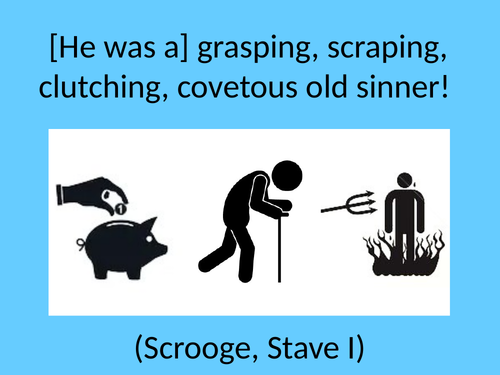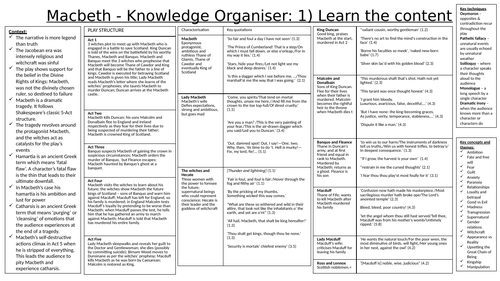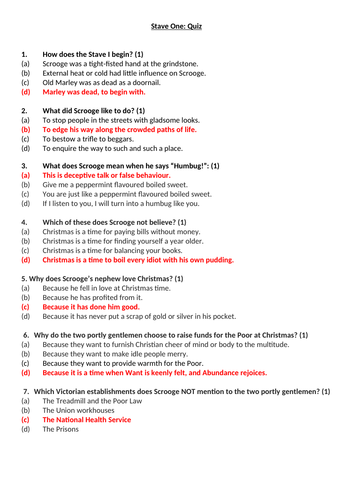67Uploads
19k+Views
7k+Downloads
All resources

A Christmas Carol - Quotations and Pictograms Display
18 Powerpoint slides with the most important quotations from A Christmas Carol, with pictograms to aid memory.
Each slide includes the pictogram, the full quotation, the character who says the quotation and the stave.
Slides can be projected to revise quotations, or can be printed and displayed in the classroom.
According to dual coding theory, imagery accompanied by words, enhances recall as two separate but linked memory traces are laid down, one in each of the memory stores.

AQA English Language Paper 1 Crib Sheet
Q1 - Q5 question formats, marks, timings, suggested response structures and suggested sentence openers
Printable colour A4 sheet on two sides including Q1, Q2, Q3, Q4 and Q5 (full page on reverse side)
Q1 – comprehension
Q2 – language analysis
Q3 – structure analysis
Q4 – evaluation
Q5 – creative writing
Compact sheet which pupils can use in lessons to support writing exam responses. Also useful handout for pupils to use as quick revision tool leading up to exam.
Bundle

A Christmas Carol: difficult words or phrases explained in modern English Stave by Stave
Dickens’ vocabulary can be difficult for some pupils (and, at times, teachers too!). These powerpoints list all those words and phrases that would typically present difficulties and offer easy translations into modern English, or into language that teenagers would more readily understand.
Just display on a projector during guided reading so that pupils can look up any words they don’t understand, or even take notes in their own books if they wish.

Unseen Poetry - Lesson 5 (Comparison)
LO: How do I compare language, form and structure used by writers to create meanings and effects?
A complete lesson including starter, unseen poems, exam question, model responses, plenary that explores a Paper 2-style AQA English Literature unseen poetry question based on the following poems: Grace Hazard Conkling: Cedars and Nicolaus Lenau: The Oak-Wood.
Powerpoint: 15 slides.
AQA English Lit Paper 2 Section C Unseen Poetry
Purpose of unit of work: To master questions 27.1 and 27.2
Form: Exam paper responses
Assessment Objectives:
AO1 - Read, understand and respond to texts, maintaining a critical style and developing an informed personal response, using textual references including quotations to support and illustrate interpretations (12 marks).
AO2 - Analyse the language, form and structure used by a writer to create meanings and effects, using relevant subject terminology where appropriate (12 marks).
AO2 - Comparison of AO2 (8 marks)
STIMULATE AND GENERATE
Focus on engagement, discussion and building cultural capital
CAPTURE, SIFT AND SORT
Sifting the outcomes from the first phase to fit where we are heading. What skills do pupils need to learn in order to be successful in the next phase?
Focus on teaching, modelling and developing key skills and processes linked to success criteria
CREATE, REFINE AND EVALUATE
More independent application of skills learnt. This is the stage that needs most differentiation and allows/enables writers to work at different rates and pitches. Self, peer and teacher review happens throughout this phrase.
Write extended responses to exam questions, provide feedback and refine work
Starter: Which words make the forest sound MYSTERIOUS? Which words make the forest sound SACRED?
Key question: What language form and structural techniques can I compare?
Unseen poems: Read both poems: Grace Hazard Conkling: Cedars and Nicolaus Lenau: The Oak-Wood¬ – 7 steps to read and understand
Exam question: In Cedars and The Oak-Wood the speakers describe the woods. What are the similarities and/or differences between the ways the woods are presented?
How do I structure my poetry comparison essay?: 5 steps
Task: Comparison table.
The structure of a comparative paragraph: Go through points.
I DO: Model comparative paragraph (first half).
YOU DO: Use this model to help you write the second half of the comparative paragraph.
SELF-ASSESSMENT: Check the model paragraph. Now write your own paragraph comparing form and structure. What makes this comparative paragraph successful? Use the example to help you write your own comparative paragraph about a DIFFERENT method and effect.
Plenary: Peer Assessment - Read through your partner’s response. Highlight and annotate their response to show where they have demonstrated WHAT WHERE HOW WHY. Write a brief commentary below their work in which you explain the following: What went well (WWW). What do they need to do in order to improve? (EBI).

Unseen Poetry - Lesson 1 (Interpretation)
LO: How do I develop an informed, personal interpretation supported by textual references?
A complete lesson including starter, unseen poem, exam question, model responses, plenary that explores a Paper 2-style AQA English Literature unseen poetry question based on the following poem: Robert Frost: The Road Not Taken.
These resources can be adapted for use with different poems and questions by other exam boards.
Powerpoint: 13 slides.
AQA English Lit Paper 2 Section C Unseen Poetry
Purpose of unit of work: To master questions 27.1 and 27.2
Form: Exam paper responses
Assessment Objectives:
AO1 - Read, understand and respond to texts, maintaining a critical style and developing an informed personal response, using textual references including quotations to support and illustrate interpretations (12 marks).
AO2 - Analyse the language, form and structure used by a writer to create meanings and effects, using relevant subject terminology where appropriate (12 marks).
AO2 - Comparison of AO2 (8 marks)
STIMULATE AND GENERATE
Focus on engagement, discussion and building cultural capital
CAPTURE, SIFT AND SORT
Sifting the outcomes from the first phase to fit where we are heading. What skills do pupils need to learn in order to be successful in the next phase?
Focus on teaching, modelling and developing key skills and processes linked to success criteria
CREATE, REFINE AND EVALUATE
More independent application of skills learnt. This is the stage that needs most differentiation and allows/enables writers to work at different rates and pitches. Self, peer and teacher review happens throughout this phrase.
Write extended responses to exam questions, provide feedback and refine work
Starter: ‘two roads diverging’ Which road would you take? Why? How important is the choice you make?
Key question: who is ‘in charge’ of the meaning of a poem?
Unseen poem: Robert Frost: The Road Not Taken. Glossary
Comprehension check: Show summary of meaning of the poem
Interpretation check: Focus on the feelings and the overall message of the poem. What do you think the point being made might be?
Exam question: In The Road Not Taken, how does the poet present ideas about making choices? Steps to understanding an unseen poem: AO1 4 steps.
Task: Show 3 different interpretations of the poem.
Which do you agree with most and why?
Discuss: Are there any comments that you disagree with? Why? Do you have your own interpretation of the poem which is different?
Plenary: Key question: who is ‘in charge’ of the meaning of a poem?

Unseen Poetry Scheme of Work (7 lessons + exam practice)
Unseen Poetry AQA English Literature Paper 2 Section C - 27.1 and 27.2
Powerpoint including over 100 slides split into 7 lessons and final exam style questions 27.1 and 27.2
Typically, lessons include: starter activity, lesson objective (linked to AOs), one unseen poem (or two for comparative lessons), glossary, practice exam questions, model responses, WHAT, WHERE, HOW, WHY analysis, pupil tasks, plenary.
Lesson objectives:
How do I develop an informed, personal interpretation supported by textual references?
How do I read, understand and respond to an unseen poem?
How do I analyse the form and structure used by a writer to create meanings and effects?
How do analyse the language used by a writer to create meanings and effects using relevant subject terminology?
How do I compare language, form and structure used by writers to create meanings and effects, using relevant subject terminology?
How do I plan and write a response to 27.1?
How do I plan and write a response to 27.2?
Exam practice: Unseen poetry questions 27.1 and 27.2

Dr Jekyll and Mr Hyde: Chapter 4 difficult words or phrases explained in modern English
Stevenson’s vocabulary can be difficult for some pupils (and, at times, teachers too!). This powerpoint lists all those words and phrases that would typically present difficulties and offers easy translations into modern English, or into language that teenagers would more readily understand.
Just display on a projector during guided reading so that pupils can look up any words they don’t understand, or even take notes in their own books if they wish.

Dr Jekyll and Mr Hyde: Chapter 5 difficult words or phrases explained in modern English
Stevenson’s vocabulary can be difficult for some pupils (and, at times, teachers too!). This powerpoint lists all those words and phrases that would typically present difficulties and offers easy translations into modern English, or into language that teenagers would more readily understand.
Just display on a projector during guided reading so that pupils can look up any words they don’t understand, or even take notes in their own books if they wish.

Dr Jekyll and Mr Hyde: Chapter 8 difficult words or phrases explained in modern English
Stevenson’s vocabulary can be difficult for some pupils (and, at times, teachers too!). This powerpoint lists all those words and phrases that would typically present difficulties and offers easy translations into modern English, or into language that teenagers would more readily understand.
Just display on a projector during guided reading so that pupils can look up any words they don’t understand, or even take notes in their own books if they wish.

Dr Jekyll and Mr Hyde: Chapter 10 difficult words or phrases explained in modern English
Stevenson’s vocabulary can be difficult for some pupils (and, at times, teachers too!). This powerpoint lists all those words and phrases that would typically present difficulties and offers easy translations into modern English, or into language that teenagers would more readily understand.
Just display on a projector during guided reading so that pupils can look up any words they don’t understand, or even take notes in their own books if they wish.

1920s Extracts Reading Homework with Multiple Choice questions - 7 Weeks
7 weeks’ worth of reading homework tasks based on extracts from texts set or written in the 1920s.
27 x A4 printable Powerpoint slides (2 to 4 sheets per lesson, including extract and questions). Can be printed into a booklet.
Easy and quick to self-assess in class as responses are chosen from multiple choices.
Tasks focus on comprehension, inference, vocabulary, sentence structures and punctuation.
Extracts from:
1 - To the Lighthouse by Virginia Woolf
2 - The Gangs of New York by Herbert Asbury
3 - The Mysterious Affair at Styles by Agatha Christie
4 - The Enormous Room by E.E. Cummings
5 - The Waste Land by T.S. Eliot
6 - Ulysses by James Joyce
7 - We by Yevgeng Zamyatin

Writing Practice Homework: Paragraphs - 5 Weeks
5 weeks’ worth of homework tasks including one page of learning and one page of related activities as A4 Word editable and printable booklet.
Easy and quick to self-assess in class .
Tasks focus on the following:
Homework 1 – Functional paragraphing
Functional paragraphing examples
TIP TOP
Complete the activities:
Insert the paragraphs
Correct the paragraphs
Homework 2 – Purposeful paragraphing
Purposeful paragraphing examples
Complete the activities:
Insert the paragraphs
Homework 3 – Paragraphing direct speech
What is indirect speech?
What is direct speech?
The general rules of direct speech
Complete the activities:
Insert the paragraphs
Homework 4 – Making paragraph choices
Sustain or maintain the same style
Develop
Contrast
Complete the activities:
Develop
Contrast
Homework 5 – Organising a text
Topic sentences
Sentence expansion
Complete the activities:
Add the topic sentences and discourse markers
Sentence expansion

Dr Jekyll and Mr Hyde: Chapter 3 difficult words or phrases explained in modern English
Stevenson’s vocabulary can be difficult for some pupils (and, at times, teachers too!). This powerpoint lists all those words and phrases that would typically present difficulties and offers easy translations into modern English, or into language that teenagers would more readily understand.
Just display on a projector during guided reading so that pupils can look up any words they don’t understand, or even take notes in their own books if they wish.

Power & Conflict Poetry Part One (Teacher copy)
5 weeks’ worth of reading homework tasks based on Power and Conflict Poetry.
17 x A4 printable Powerpoint slides (3 sheets per lesson, including poem and questions). Can be printed into a booklet.
Easy and quick to self-assess in class as responses are chosen from multiple choices.
This is the teacher copy, with correct answers already highlighted. A separate file is available to purchase, without correct answers highlighted, designed for pupil use.
Tasks focus on comprehension, selecting relevant evidence, poetic devices analysis, writer’s ideas and themes.
Poems:
1 - Percy Bysshe Shelley - Ozymandias
2 - William Blake - London
3 - William Wordsworth - Extract from, The Prelude
4 - Robert Browning - My Last Duchess
5 - Alfred Lord Tennyson - The Charge of the Light Brigade

Power & Conflict Poetry Part One
5 weeks’ worth of reading homework tasks based on Power and Conflict Poetry.
17 x A4 printable Powerpoint slides (3 sheets per lesson, including poem and questions). Can be printed into a booklet.
Easy and quick to self-assess in class as responses are chosen from multiple choices.
A separate file is available to purchase, with correct answers clearly highlighted for all 5 poems.
Tasks focus on comprehension, selecting relevant evidence, poetic devices analysis, writer’s ideas and themes.
Poems:
1 - Percy Bysshe Shelley - Ozymandias
2 - William Blake - London
3 - William Wordsworth - Extract from, The Prelude
4 - Robert Browning - My Last Duchess
5 - Alfred Lord Tennyson - The Charge of the Light Brigade

A Christmas Carol Knowledge Organiser Flashcard
A printable A3 Knowledge Organiser for Macbeth including Context, Plot, Characters, Quotations, Key Terms and Themes.
Designed as a large flashcard:
Part 1: Learn the content
Part 2: Test yourself (turn sheet over and fill empty template)
Perfect for exam revision.

Macbeth Knowledge Organiser Flashcard
A printable A3 Knowledge Organiser for Macbeth including Context, Plot, Characters, Quotations, Key Terms and Themes.
Part 1: Learn the content
Part 2: Test yourself (turn sheet over and fill empty template)
Perfect for exam revision.

Power & Conflict Poetry Part Two (Teacher Copy)
Answers Booklet
5 weeks’ worth of reading homework tasks based on Power and Conflict Poetry.
17 x A4 printable Powerpoint slides (3 sheets per lesson, including poem and questions). Can be printed into a booklet.
Easy and quick to self-assess in class as responses are chosen from multiple choices.
This is the teacher copy, with correct answers already highlighted. A separate file is available to purchase, without correct answers highlighted, designed for pupil use.
Tasks focus on comprehension, selecting relevant evidence, poetic devices analysis, writer’s ideas and themes.
Poems:
1 - Wilfred Owen - Exposure
2 - Seamus Heaney - Storm on the Island
3 - Ted Hughes - Bayonet Charge
4 - Simon Armitage - Remains
5 - Jane Weir - Poppies

American Literature from the 1930s Extracts Reading Homework Multiple Choice Questions - 7 Weeks
7 weeks’ worth of reading homework tasks based on extracts from American texts published in the 1930s.
Easy and quick to self-assess in class as responses are chosen from multiple choices.
Tasks focus on comprehension, inference, vocabulary, sentence structures and punctuation.
Extracts from:
1 - The 42nd Parallel by Jon Dos Passos (1930)
2 - As I Lay Dying by William Faulkner (1930)
3 - Tender is the Night by F. Scott Fitzgerald (1934)
4 - The Snows of Kilimanjaro by Ernest Hemingway (1936)
5 - Their Eyes Were Watching God by Zora Neale Hurston (1937)
6 - The Grapes of Wrath by John Steinbeck (1939)
7 - The Day of the Locust by Nathanael West (1939)

A Christmas Carol Quiz - Stave 1
A Christmas Carol Stave 1 Quiz and Answers worksheet
A post-reading resource or revision activity to check understanding of Stave 1. Pupils can peer or self-assess using the answers sheet which can be read out by teacher, projected or printed.
Worksheet includes:
15 multiple choice questions on 2 A4 pages - pupils to select options a) b) c) d)
Questions cover a range of topics from basic comprehension, to inference, to grammar, quotation recall, and contextual understanding.
Also included, the answers worksheet where correct answers are highlighted in red.




















